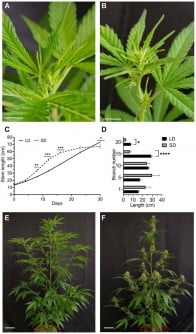
A team of researchers from the Volcani Institute in Israel has made significant strides in understanding the hormonal mechanisms that govern cannabis flowering. Their findings, published on September 3, 2024, in the journal Horticulture Research, reveal how light cycles and the plant hormone gibberellin interact to influence the development of cannabis flowers, which are crucial for both medicinal and recreational uses.
The research highlights the importance of the photoperiod, or the duration of light exposure, in the flowering process of Cannabis sativa L.. The timing and density of female flowers directly impact crop yield and the concentration of bioactive compounds such as THC and CBD. While it is known that early flowering can occur independently of light cycle, the mechanisms controlling full floral maturation have remained largely unclear until now.
Through a series of light cycle experiments combined with hormone treatments, the research team demonstrated that short-day (SD) conditions are essential for initiating and sustaining inflorescence development. Specifically, low levels of gibberellin are crucial during this phase. When the light conditions are altered or gibberellin is applied externally, the balance is disrupted, resulting in elongated stems and dispersed flowers.
The study identified a two-phase response in mature cannabis plants under SD lighting. Initially, there is a rapid growth phase characterized by stem elongation. However, by day ten, this elongation ceases, and compact flower clusters begin to form. This transition is associated with a decrease in the levels of gibberellin (specifically GA4) and auxin in the plant’s shoot apex. Remarkably, just three days of SD exposure were enough to initiate inflorescence development, but continuous SD was necessary to maintain it.
When conditions reverted to long-day (LD) settings, hormone levels returned to baseline, floral clustering was reversed, and vegetative growth resumed. Further experiments revealed that applying gibberellin under SD conditions had effects similar to those observed during LD exposure, disrupting flower development and significantly reducing key cannabinoids like THC and CBD. Treatments with auxin, on the other hand, showed minimal impact, underscoring the dominant role of gibberellin in this process.
Dr. Ben Spitzer-Rimon, the lead author of the study, stated, “Cannabis inflorescence development is a reversible, hormone-dependent process that requires a precise photoperiod. Our results show that even after flowers begin to form, returning to long days or increasing gibberellin levels can dismantle the process.” This discovery could revolutionize how cannabis is cultivated, making production more predictable and efficient.
The implications of these findings extend beyond academic curiosity. For commercial cannabis growers, understanding that continuous SD lighting is necessary to maintain flower clusters empowers them to time flowering precisely, thereby enhancing quality and consistency. Additionally, manipulating gibberellin levels presents a novel approach to controlling plant architecture and potentially increasing cannabinoid yields.
For the pharmaceutical industry, where flower density and chemical consistency are paramount, this research provides a valuable roadmap for optimizing production processes. As the global cannabis sector continues to expand, insights such as these will be crucial in refining growth protocols and breeding strategies.
This study was supported by the Chief Scientist of the Israeli Ministry of Agriculture and Rural Development and involved collaboration with Canndoc Ltd, a certified commercial cultivation producer in Israel. The research adds to the growing body of knowledge essential for advancing cannabis cultivation practices and enhancing the quality of products available to consumers and patients alike.







